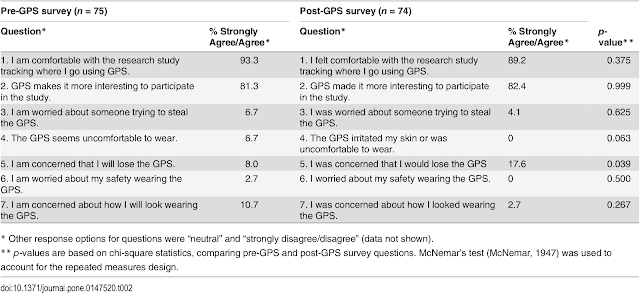Feasibility and Acceptability of Global Positioning System (GPS) Methods to Study the Spatial Contexts of Substance Use and Sexual Risk Behaviors among Young Men Who Have Sex with Men in New York City
BACKGROUND:
No
global positioning system (GPS) technology study has been conducted among a
sample of young gay, bisexual, and other men who have sex with men (YMSM). As
such, the purpose of this study was to evaluate the feasibility and
acceptability of using GPS methods to understand the spatial context of
substance use and sexual risk behaviors among a sample of YMSM in New York
City, a high-risk population.
METHODS:
Data came
from a subsample of the ongoing P18 Cohort Study (n = 75). GPS feasibility and
acceptability among participants was measured with: 1) a pre- and post-survey
and 2) adherence to the GPS protocol which included returning the GPS device,
self-report of charging and carrying the GPS device as well as objective data
analyzed from the GPS devices. Analyses of the feasibility surveys were treated
as repeated measures as each participant had a pre- and post-feasibility
survey. When comparing the similar GPS survey items asked at baseline and at
follow-up, we present percentages and associated p-values based on chi-square
statistics.
RESULTS:
Participants
reported high ratings of pre-GPS acceptability, ease of use, and low levels of
wear-related concerns in addition to few concerns related to safety, loss, or
appearance, which were maintained after baseline GPS feasibility data
collection. The GPS return rate was 100%. Most participants charged and carried
the GPS device on most days. Of the total of 75 participants with GPS data, 75
(100%) have at least one hour of GPS data for one day and 63 (84%) had at least
one hour on all 7 days.
CONCLUSIONS:
Results
from this pilot study demonstrate that utilizing GPS methods among YMSM is
feasible and acceptable. GPS devices may be used in spatial epidemiology
research in YMSM populations to understand place-based determinants of health
such as substance use and sexual risk behaviors.
Below: Comparison of Pre- and Post-GPS Feasibility and Acceptability Survey Items
By: Duncan DT1,2,3,4,5,6, Kapadia F1,2,3,4,5, Regan SD1, Goedel WC1,2, Levy MD4, Barton SC4, Friedman SR5,7, Halkitis PN1,2,3,4,5.
- 1Department of Population Health, New York University School of Medicine, New York, NY, United States of America.
- 2College of Global Public Health, New York University, New York, NY, United States of America.
- 3Population Center, New York University, New York, NY, United States of America.
- 4Center for Health, Identity, Behavior and Prevention Studies, New York University, New York, NY, United States of America.
- 5Center for Drug Use and HIV Research, New York University College of Nursing, New York, NY, United States of America.
- 6Center for Data Science, New York University, New York, NY, United States of America.
- 7Institute of Infectious Disease Research, National Development and Research Institutes, Inc., New York, NY, United States of America.
- PLoS One. 2016 Feb 26;11(2):e0147520. doi: 10.1371/journal.pone.0147520.



No comments:
Post a Comment